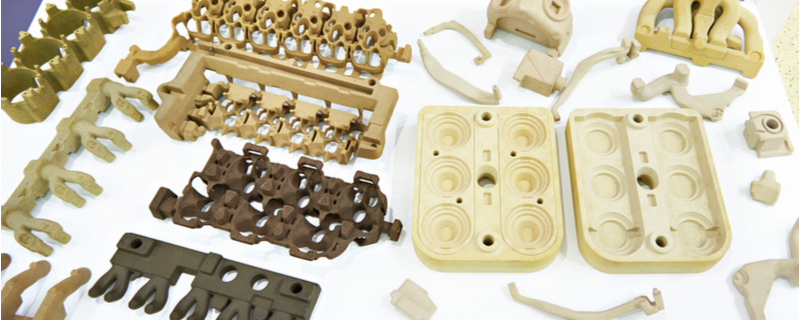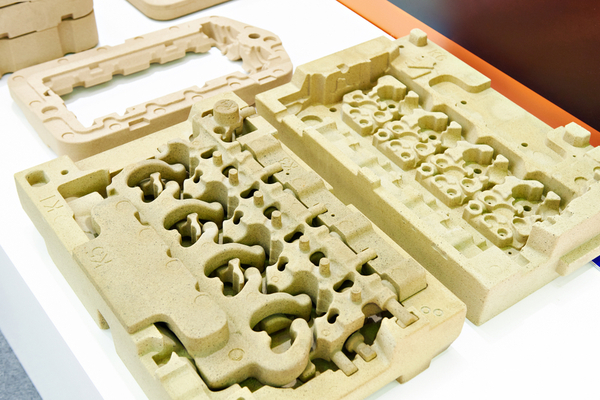The Benefits of Using 3D Printing in the Sand Casting Process

3D printing as a production technology process has impacted the manufacturing industry more than anyone expected. Advancements in sand casting and printed molds have resulted in production processes that are faster, cheaper, and higher quality than traditional methods. Let’s find out why and how manufacturers are increasingly using 3D printing technology for industrial applications.
Traditional Sand Casting vs. 3D Sand Printing
Sand casting is a casting method that involves using a mold made of sand as a negative impression for producing metal parts. Conventional sand casting has been used for thousands of years, primarily following these basic steps: First, a part shape, runner, and gates are placed into the sand to form a mold. Second, molten metal is poured into the mold, where it cools and solidifies. Finally, the sand mold is broken away, revealing the finished product. While this process is highly effective, it is not as time-efficient or affordable as alternative casting methods.
3D printing, or additive manufacturing, is the process of creating three-dimensional objects from a digital model. 3D printing molds for casting saves time by printing patterns directly and skipping the otherwise lengthy mold-making process.
The 3D Sand Casting Process
Essentially, 3D sand casting works like an inkjet printer, but instead of ink and paper, it prints binder material onto a sand layer. It is a highly efficient solution for manufacturers for many reasons. Let’s go through the steps of the 3D printing process.
- First, ensure that the 3D CAD (computer-aided design) files are complete and ready for production.
- Choose a material and binder combination for your casting mold. Consider your final casting material when selecting these options. Common types of metal that can be cast in sand molds are aluminum, steel, magnesium, and iron.
- The 3D printer will begin by leveling a thin layer of sand onto the building platform. Next, the printer dispenses binding material in the desired pattern, continuing the process on each new leveled layer until completion.

Some curing or finishing may be required before or after the cast has been poured, but this method of mold creation still achieves near-net-shape casting.
Advantages of 3D Printed Sand Molds
3D printing significantly improves the sand casting process. When these two technologies work together, they produce high-quality 3D printed sand cores and molds that can be used for a wide range of industry applications. Let’s explore the top benefits of this modern casting technology:
Design Freedom
One of the ultimate advantages of 3D sand casting is design freedom. Digital editing allows mold and core designs to be carried out accurately and efficiently. Even the largest and most complex design files can be brought to life in record time. In addition, this quick process gives engineers the ability to easily redesign the molds, if necessary.
Reduced Costs
3D sand printing offers significant economic advantages. Models are made quickly and without the need for expensive patterns. Because the molds are produced entirely digitally and without tools, overall costs will be substantially lower.
Quick Turnaround
3D sand printing is incredibly time-saving when compared to conventional sand casting methods. By eliminating the need for tool and mold making, 3D printing can speed up the manufacturing time by up to 75%. 3D-printed molds or cores can be produced within hours and fully completed in just a few days. Meanwhile, traditional molds are notorious for taking several weeks to finish. In addition to the quick response time, there also is minimal downtime between batches.
Improved Efficiency
3D printing technology effectively builds parts, components, and prototypes using various materials. This method is faster and cheaper than traditional sand casting processes, making it the optimal solution with maximum efficiency. 3D sand molds can be successfully printed on large scales or small scales.
Reduced Material Waste
3D printing allows manufacturers to make changes to a prototype with a simple edit to the design file. 3D printed casting patterns are saved and stored digitally, with no need for physical storage space. Plus, any leftover material from printing and binding can be easily reused.

Contact PumpWorks Castings for 3D Sand Printing Services Today
When you combine 3D printing technology and sand casting, you get the perfect hybrid for mold manufacturing. Modern 3D sand printing is ideal for producing quality parts while effectively reducing costs and saving time.
PumpWorks Castings is a fully integrated industrial casting foundry that provides various casting services, including modern 3D sand casting, investment casting, on-site engineering services, and more. Contact us online today to speak with a PumpWorks Castings engineer about how our advanced 3D sand printing solutions can serve your needs.
